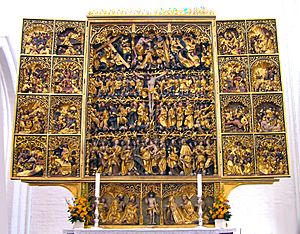Passion (music) facts for kids
In Christian music, a Passion is a special musical piece that tells the story of Jesus Christ's last days. This includes his suffering, trial, and death. These musical works are often performed during Holy Week, which is the week leading up to Easter.
Passion music started a long time ago in the Middle Ages. At first, it was just the Gospel stories about Jesus's Passion read aloud or chanted. Later, composers began to add more complex music, with different singers playing different characters like Jesus, the narrator, or the crowd. This led to the development of different styles, including pieces where all the text was sung by a choir.
In Protestant Germany, Passion music became very important during Passiontide (the time before Easter). Famous examples include the Bach Passions from the 1700s. Even today, modern works like the Jesus Christ Superstar rock opera are inspired by these old Christian traditions.
Contents
History of Passion Music
Early Beginnings
The tradition of reading the Passion story from the Gospels during Holy Week is very old. It dates back at least to the 4th century. By the 5th century, specific Gospels were chosen for different days. For example, the Gospel of John was often read on Good Friday.
Over time, these readings became more musical. By the 8th century, people started to chant the Passion story instead of just speaking it. In the 13th century, a new idea emerged: different singers would take on the roles of different characters. One singer might be Jesus, another the narrator, and a group of singers would represent the crowd (called Turba).
New Musical Styles
By the late 1400s, new ways of composing Passion music appeared:
- Responsorial Passions: In these, the narrator's part was chanted, but the parts for the crowd or Jesus were sung with more complex music by a choir.
- Through-composed Passions: Here, all the words, from every character, were set to complex music for a choir. One of the earliest examples might be by Jacob Obrecht.
- Summa Passionis: These combined parts of the Passion story from all four Gospels. Even though they weren't used in church services, they were very popular. This style also included the "Seven Last Words" of Jesus.
Passion Music in Catholicism
In the 16th century, many composers wrote Passion settings, mostly in the responsorial style. Famous composers like William Byrd, Orlando di Lasso, and Victoria created these works.
However, in Roman Catholicism, other musical forms became more common for remembering Jesus's Passion during Holy Week. These included settings for the Tenebrae service, which featured pieces like Leçons de ténèbres and settings of the Miserere psalm. Some of these works, like Gesualdo's Tenebrae Responsoria, were so dramatic they were almost like Passions themselves.
Later, Catholic Passion music developed into "passion-oratorios." These were like musical plays that told the story of Jesus's Passion. A famous example is Metastasio's La passione di Gesù Cristo, which was set to music by many composers.
Protestant Passion Music
Even though Martin Luther believed the Passion should be lived out, sung Passion performances were common in Lutheran churches from the very beginning. These were sung in both Latin and German.
In the 17th century, a new style called "oratorio" passions emerged. These were larger works, often with instruments playing along. They also included extra musical parts like instrumental interludes or additional texts. Composers like Heinrich Schütz created such settings.
Johann Sebastian Bach's Passions
The most famous Protestant Passion settings are by Johann Sebastian Bach. He is believed to have written five Passions, but only two have survived completely:
- The St John Passion, based on the Gospel of John.
- The St Matthew Passion, based on the Gospel of Matthew.
Bach's Passions are very popular today, but they were not performed often during his own lifetime.
After Bach, Passion music remained very popular in Protestant Germany throughout the 18th century. Many other important composers, such as Carl Philipp Emanuel Bach (Bach's son), Georg Philipp Telemann, and George Frideric Handel, also wrote Passions.
Modern Passion Music
In the 19th century, Passion settings became less common. However, they made a comeback in the 20th century.
Some important modern examples include:
- The St. Luke Passion (1965) by Krzysztof Penderecki from Poland.
- The Passio (1982) by Arvo Pärt from Estonia.
In the year 2000, a special project commissioned four modern composers to write new Passions based on each of the four Gospels. These included works by Tan Dun, Osvaldo Golijov, Wolfgang Rihm, and Sofia Gubaidulina.
Examples of Passion Music
English Language Passions
In English, two classic Passion works are The Crucifixion (1887) by Sir John Stainer and Olivet to Calvary (1904) by John Henry Maunder.
More recent examples include:
- James MacMillan's Seven Last Words from the Cross (1993).
- Andrew Lloyd Webber's Jesus Christ Superstar (with lyrics by Tim Rice), which is a rock opera with elements of the traditional Passion story.
- Stephen Schwartz's Godspell, which also includes parts of the Passion accounts.
- Peter Gabriel's album Passion: Music for The Last Temptation of Christ, which was the music for a film.
German Language Passions
German Passion cantatas (a type of musical work) include:
- Der Tod Jesu (1755) by Georg Philipp Telemann, Carl Philipp Emanuel Bach, and Carl Heinrich Graun.
- Die letzten Leiden des Erlösers (1770) by Carl Philipp Emanuel Bach.
- Das Sühnopfer des neuen Bundes (1847) by Carl Loewe.
Latin Language Passions
A notable work in Latin is Membra Jesu Nostri (1680) by Dieterich Buxtehude. This work is a cycle of seven short musical pieces based on a medieval poem.
Another important Latin work is Arvo Pärt's Passio Domini Nostri Jesu Christi secundum Joannem (The Passion of Our Lord Jesus Christ according to John) from 1982.
Other Notable Passions
- St. Luke Passion (1966) by Krzysztof Penderecki.
See also
 In Spanish: Pasión (música) para niños
In Spanish: Pasión (música) para niños


